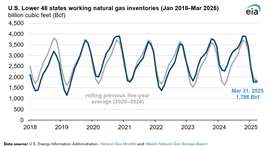Gas storage trends shift as injection season starts early
April 28, 2025
Mountain and Pacific regions maintain surpluses while inventories elsewhere fall below average, EIA reports

Working natural gas inventories in the Mountain and Pacific regions closed the winter heating season well above historical norms, according to the U.S. Energy Information Administration (EIA).
At the end of March, working gas inventories stood 53% above the five-year average in the Mountain region and 18% higher than average in the Pacific region. In contrast, inventories in other regions of the Lower 48 states fell below seasonal averages following steady withdrawals through the winter months.
At the beginning of the heating season last November, natural gas inventories in all regions of the Lower 48 were above their five-year averages. However, stronger-than-typical withdrawals caused by regional weather patterns gradually eroded those surpluses. By the end of December, working gas levels in the East and Midwest regions had fallen below average, and the South Central region followed by the end of January.
Unseasonably warm temperatures in March shortened the withdrawal season and led to net injections into underground storage facilities, signaling an earlier-than-normal start to the 2025 injection season. As of March 31, total working gas in storage in the Lower 48 stood at 1,786 billion cubic feet (Bcf), the EIA said.
The regional imbalances reflect both variable weather across the country and differences in supply and demand dynamics, which could influence natural gas markets as the summer cooling season approaches.
MAGAZINE
NEWSLETTER

CONNECT WITH THE TEAM







